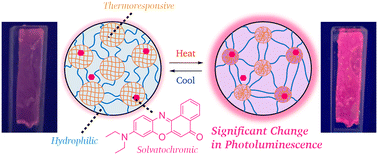Stimuli-responsive hydrogels that allow simultaneous changes in multiple properties, including photoluminescence, are attractive for various applications such as sensing materials because such gels can visually represent environmental changes. In developing such novel materials, it is essential to precisely design the network structure at the nanoscale for hybridization with an appropriate dye. In this study, we designed gels with a thermoresponsive crosslinked nanodomain (CD) structure containing Nile Red, a solvatochromic dye, via the polymerization-induced self-assembly (PISA) process. The synthesis was achieved using reversible addition–fragmentation chain transfer (RAFT) polymerization of N-isopropylacrylamide (NIPAAm) from a hydrophilic bifunctional macro-chain transfer agent in an aqueous dispersion of Nile Red at a high temperature. The obtained gels appeared blue under visible light and showed faint red fluorescence under UV irradiation, while it rapidly turned reddish purple and exhibited red fluorescence without syneresis upon heating. These changes in appearance and photoluminescence were derived from changes in the microenvironment around Nile Red, induced by reversible swelling/shrinking of PNIPAAm nanodomains within the hydrogel network. Moreover, these internal structural changes simultaneously altered the mechanical properties along with the changes in appearance and photoluminescence on a similar timescale.
